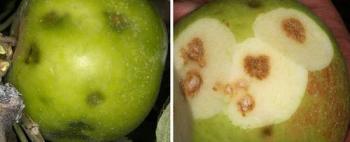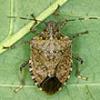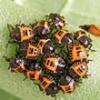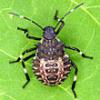Brown Marmorated Stink Bug ID and Biology
Identification
The Brown Marmorated Stink Bug (BMSB) has a "shield" shaped body that is characteristic of all stink bugs. The adults are approximately 17 mm (5/8 inch) long with a mottled brownish grey color. The next to last (4th) antennal segment has a white band and several of the abdominal segments protrude from beneath the wings and are alternatively banded with black and white. The underside is whiteish, sometimes with grey or black markings, and the legs are brown with faint white banding.
BMSB has five nymphal stages, or instars, and ranges in size from 2.4 mm to 12 mm in length. Nymphs are brightly colored with red and black, contrasting with the adults, whose coloring provides camouflage against bark. The first instars, which have a "tick-like" appearance, are not very active and remain around the hatched egg mass. Nymphs are characterized by dark reddish eyes and a yellowish-red abdomen that is also striped with black. The legs and antennae of the nymphs are black with white banding.
The eggs of the Brown Marmorated Stink Bug are often laid on the underside of leaves and a light green in color. They are elliptical in shape and are often deposited in a mass of approximately 28 eggs.
Life Cycle and Habitat
Understanding the biology and life cycle of Halyomorpha halys is necessary to prevent its spread and minimize the damage it causes to fruit and vegetable crops in Massachusetts. Its generalized feeding behavior, large migratory range, unique overwintering habits and the lack of native predators have allowed the Brown Marmorated Stinkbug (BMSB) to spread rapidly.
- Adults emerge from their winter habitats in the spring (Late April through early June) and begin mating in about two weeks.
- Research suggests that emergence in the spring is triggered by increased daylight hours rather than temperature, although warm springs and summers may permit increased reproductivity.
- BMSB mates multiple times in a season. Depending on temperatures, BMSB will produce one generation or possibly two per year in Massachusetts. However, in parts of sub-tropical China, records indicate from four to possibly six generations per year.
- Can feed on virtually any green plant, but prefers tree fruits and some vegetable crops. Adults tend to be in the upper canopies of trees.
- Early-stage nymphs do not venture very far from the newly hatched egg mass, but adults migrate throughout the growing season, feeding on a range of range of fruits and other plants.
- Many generations or life stages of BMSB can be represented at the same time and place at any point in the season due to staggered emergence in spring.
- Starting in September through the first half of October, adults take refuge in built structures like homes and warehouses, as well as in dead trees in forested areas.
Damage
 In its native range, BMSB feeds on a wide variety of host plants. In the United States, BMSB damage has been reported on vegetable crops such as sweet corn, tomatoes, lima beans, soybeans, and green peppers. It is likely that the list of affected crops will grow as this pest spreads and populations become established in new areas. Fruits attacked include apples, peaches, figs, mulberries, citrus fruits and persimmons. This true bug has also been reported on many ornamental plants, and weeds.
In its native range, BMSB feeds on a wide variety of host plants. In the United States, BMSB damage has been reported on vegetable crops such as sweet corn, tomatoes, lima beans, soybeans, and green peppers. It is likely that the list of affected crops will grow as this pest spreads and populations become established in new areas. Fruits attacked include apples, peaches, figs, mulberries, citrus fruits and persimmons. This true bug has also been reported on many ornamental plants, and weeds.
As it feeds throughout the season, the timing of feeding can drastically alter the type and appearance of the injury. For example, early season feeding usually causes misshapen fruit, whereas late season feeding usually causes depressions on the fruit surface and the appearance of necrotic tissue just below the fruit surface.
Links and Additional Resources:
For Identification:
https://ag.umass.edu/vegetable/fact-sheets/brown-marmorated-stink-bug
http://www.stopbmsb.org/stink-bug-basics/life-stages/
To identify BMSB from look-alikes:
http://www.stopbmsb.org/stink-bug-basics/look-alike-insects/ http://njaes.rutgers.edu/stinkbug/similar.asp





